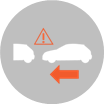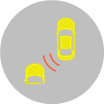How to Make Safer, More Knowledgeable Drivers—On and Off the Job
Posted on byThis blog was originally posted on MyCarDoesWhat.org
 As an employer, what can you do to help workers understand and learn how to use safety features built into vehicles they drive for work—whether you provide these vehicles, or workers drive their own vehicles?
As an employer, what can you do to help workers understand and learn how to use safety features built into vehicles they drive for work—whether you provide these vehicles, or workers drive their own vehicles?
Newer vehicles have advanced safety features most of us could not have imagined several years ago. These safety features often operate without drivers being aware of them. In certain critical situations, though, some of them trigger the vehicle to take action to avoid a crash. But, research shows that drivers have uncertainty about many of the advanced safety features available today. Additionally, according to a survey conducted by the University of Iowa, 40 percent of people reported they had experienced a situation in which their vehicle acted in an unexpected way.
Vehicles that are driven for work may have more advanced safety features than workers’ personal vehicles, and workers may not drive the same work vehicle every day. As a result, workers may be unfamiliar with advanced safety features and not understand why their vehicles behave in a certain way. You as an employer can provide workers with resources like MyCarDoesWhat from the National Safety Council and the University of Iowa, a free interactive tool that answers drivers’ questions about safety features.
Did you know…
Automatic Emergency Braking can apply the brakes—either gradually to maintain a safe following distance or even to bring your vehicle to a complete stop—to keep you from hitting the vehicle in front of you.
Drowsiness alert lets you know if you’re drowsy and suggests you take a break when it’s safe to do so.
Blind spot monitors warn you of cars in your blind spots. They may provide an additional warning if you put on your turn signal while there is a car next to you in another lane.
Explore more car safety features from MyCarDoesWhat.
As main buyers of vehicles, employers can influence vehicle safety standards. By buying vehicles with advanced safety features, employers raise the level of safety for the entire vehicle fleet. The result is safer vehicles for your own employee drivers, and safer vehicles for those with whom they share the road.
In the U.S., you can select company vehicles that have a “5-star” rating from the National Highway Traffic Safety Administration, or that are a “Top Safety Pick” from the Insurance Institute for Highway Safety. The Global New Car Assessment Programme Fleet Safety Guide and Safer Car Purchasing Policy explains vehicle safety ratings in other parts of the world, and offers a Model Purchase Policy that employers can incorporate into their road safety management systems.
Understanding how today’s vehicles keep you safer isn’t just an on-the-job priority. Your employees can share information from MyCarDoesWhat with their teenaged children who are new to driving, or with parents who are experienced drivers but may be puzzled by what their car is doing or trying to tell them.
Whether you’re working to improve the safety of your fleet, or trying to keep employees and their families safe on the road, MyCarDoesWhat is a valuable tool to help create more knowledgeable drivers.
For more information on how to promote safer workplace driving, visit the NIOSH Center for Motor Vehicle Safety.
Stephanie Pratt, PhD, is the Director of the NIOSH Center for Motor Vehicle Safety.
Rebecca Olsavsky, MS, is a Health Communications Specialist Fellow in the NIOSH Center for Motor Vehicle Safety.
NIOSH Center for Motor Vehicle Safety
Posted on by




